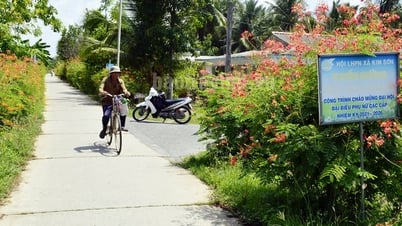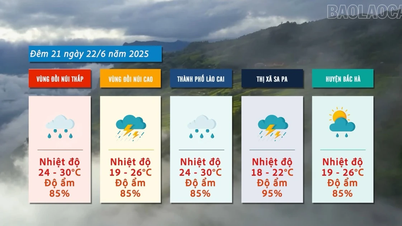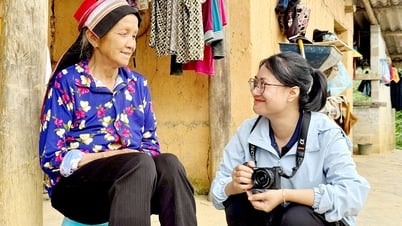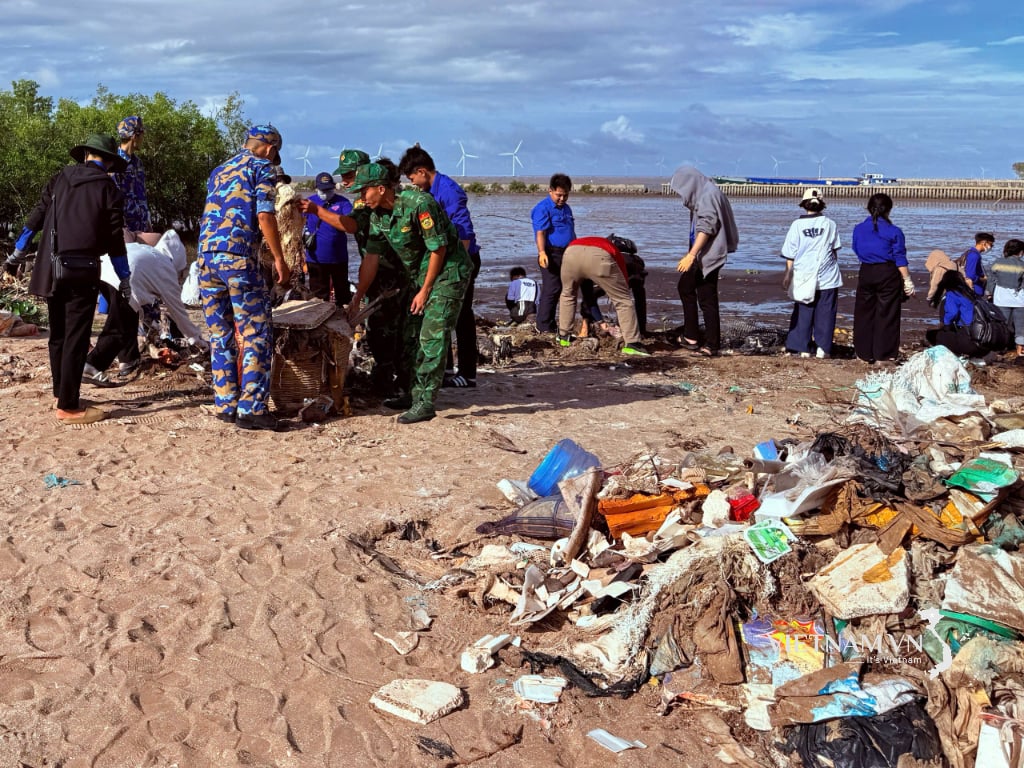Thanks to suitable environmental conditions and diverse food sources, people in the Mekong Delta have recently promoted the profession of raising swiftlets indoors. Also because of the initial high efficiency, many places are racing to build swiftlet houses, leading to many consequences for the environment, noise, and quality of swiftlets.

The first bird's nest house was built decades ago in Dinh An town (Tra Cu district, Tra Vinh province). Photo: H.TAN
Bird's nest houses increase rapidly
More than 15 years ago, the family of Ms. Tran Tu Hong, in An Binh ward (Rach Gia city, Kien Giang province) was one of the first households in the locality to "practice" raising swiftlets. She recounted: "At that time, swiftlets appeared a lot in Rach Gia city, so I started to learn about this bird species. After that, the family decided to move the newly built house with 1 ground floor and 1 upper floor, which was intended to be a place to raise chickens, to raise swiftlets. In the first 2 months, only 2 swiftlets came to live there, but after that, the flock gradually increased and after about 1 year, there were nests to harvest...".
“The first time I sold only half a kilo of raw bird’s nest, I earned 20 million VND; compared to my family’s traditional fish sauce making business, I would have to sell many barrels to earn that amount of money. Because the bird’s nest farming business was highly effective, my family later expanded the scale of production. From 2016 to 2018, on average, each harvest yielded more than 15kg of raw bird’s nest, pocketing around 300 million VND…”, Ms. Hong confided.
Seeing that many people raising swiftlets were economically effective, Ms. Nguyen Thi Thai Binh, in Vinh Lac Ward (Rach Gia City) followed suit. Ms. Binh said: “The profession of raising swiftlets is popular, so my family converted part of the motel and house to raise them. When we had a good income, we invested in building a new swiftlet house on the outskirts of Rach Gia City, ensuring standards, for long-term development. Up to now, my family has 5 swiftlet houses, a stable source of income for life…”. According to the Department of Animal Husbandry and Veterinary Medicine of Kien Giang province, from the first swiftlet houses around 2003, up to now, the whole province has nearly 3,000 swiftlet houses (the most in the country); the output in 2022 is about 17.5 tons, the selling price of raw swiftlet nests is from 15-25 million VND/kg; cleaned and canned swiftlet nests are from 30-35 million VND/kg; earning 300-350 billion VND each year.
The swiftlet farming profession in Kien Giang has been "prosperous", considered a "heavenly blessing" profession, so many other places have learned and followed suit. Mr. Nguyen Van Ba, in Chau Phu district (An Giang province), confided: "More than 5 years ago, an acquaintance invited me to learn about swiftlet farming, because this area has a lot of food sources, so I followed suit. When I returned, I hired workers to expand the house I was living in and designed an area to attract swiftlets. After several years of farming, seeing that this profession was "viable", I invested in 2 more swiftlet houses; each year I earn several hundred million VND". Along with Chau Phu district, many households in Thoai Son district, Long Xuyen city, Chau Doc city... have also developed swiftlet farming; it is estimated that the whole An Giang province has more than 1,200 swiftlet houses.
In Tra Cu coastal district, Tra Vinh province, many people also raise swiftlets. Mr. Trang Van Ngao, Chairman of the People's Committee of Dinh An town, said that more than 10 years ago, Mr. Ly Van Hanh's household was the first to raise swiftlets. On average, each harvest yielded about 2kg of raw bird's nests, selling for tens of millions of VND. From the above results, some other households also jumped into raising swiftlets...
Regarding the current issue, Mr. Ly Minh Hoang, in Rach Gia city, said: “After about 15-20 years of booming the bird's nest farming industry in Kien Giang, this industry is now showing signs of "saturation" and decline. If in the past, there were few bird's nest houses, so the number of birds coming back was large, thereby producing many bird's nests, bringing in large revenues. Now there are too many bird's nest houses, while the flocks of birds cannot reproduce fast enough to build new houses; in addition, many flocks of birds die due to old age, natural disasters, storms, rampant hunting, combined with environmental impacts, lack of food... so the number of flocks is obviously decreasing". Previously, bird's nest houses harvested 3-4 times a year, but now it has decreased to about 2 times. In addition, the bird's nests are also smaller than before and the number of nests has decreased by 30% or more compared to 2022. On the other hand, the price of raw bird's nests on the market has also decreased to 14-15 million VND/kg...

Processing bird's nest in Kien Giang province to serve consumption needs everywhere. Photo: H.TAN
Difficulty in management
It can be seen that the bird's nest farming industry in the Mekong Delta has developed rapidly in recent years. However, the "hot" development without planning or direction, mainly due to people adding more floors from their houses to build bird's nest houses in densely populated areas, urban areas... has revealed many consequences such as environmental pollution, risk of epidemics; noise affects people's lives and activities.
Faced with the above situation, the People's Councils of the Mekong Delta provinces have issued resolutions regulating areas for raising swiftlets. Mr. Nguyen Duy Hung, Head of the Department of Animal Husbandry and Veterinary Medicine of Bac Lieu province, said that the swiftlet farming profession in the province started in 2004 and has developed rapidly. To date, the province has more than 1,500 swiftlet houses. To strengthen the management of this profession, in 2022, the People's Council of Bac Lieu province will issue a resolution on "Regulations on areas for raising swiftlets in the province". The Department of Animal Husbandry and Veterinary Medicine of the province, in coordination with the Inspectorate of the Department of Agriculture and Rural Development, and related units, regularly inspects swiftlet farming facilities. Thereby, many households are detected and reminded of violations of regulations on using loudspeakers to lure birds past hours and causing noise; requiring household owners to commit to correcting their violations. In addition, the management of the construction of new swiftlet houses is strengthened. Specifically, cases of swiftlet houses that have been operating before must remain intact and must not be expanded; In the long term, there is a direction to move birdhouses out of inner-city areas and residential areas; for new birdhouses, it is absolutely not allowed to be built in urban areas or densely populated areas...
In Can Tho city, Mr. Nguyen Van Su, Director of the Department of Agriculture and Rural Development, acknowledged: “The raising of swiftlets in the past has been spontaneous; therefore, when the City People's Council issued a resolution stipulating areas where swiftlets cannot be raised, management work was strengthened. In addition, the agricultural sector of Can Tho city does not recommend raising swiftlets, and does not plan to develop this profession because it is not a local strength.”
On March 10, 2021, the People's Council of Hau Giang province issued a Resolution regulating areas where livestock farming and swiftlet farming are not allowed. Accordingly, all urban areas, residential areas, resettlement areas, residential clusters, and public works areas that have been approved by competent authorities for detailed planning at a scale of 1/500 and have had their planning announced, throughout the province, are prohibited from raising swiftlets. In addition, many places throughout the province are also prohibited from raising swiftlets and are regulated for specific road sections and areas. The Resolution stipulates that swiftlet farming areas outside areas where livestock farming is not allowed in Hau Giang province must ensure that they are suitable for the habits of swiftlets, suitable for the local socio-economic conditions, and do not affect the lives of residents in the swiftlet farming areas, ensuring the farming conditions according to regulations. This Resolution applies to Vietnamese organizations and individuals and foreign organizations and individuals involved in livestock farming activities in Hau Giang province.
According to Mr. Nguyen Thanh Duc, Head of the Department of Animal Husbandry and Veterinary Medicine of Kien Giang province, in August 2022, the Provincial People's Council issued a resolution related to the raising of swiftlets. However, in reality, the authorities encounter many difficulties every time they inspect because most of the households are private, they often make appointments this time or that time or do not want to let strangers into the bird's nest house because they are afraid of affecting the flock of swiftlets. Therefore, each inspection takes a lot of time and effort. Regarding noise in residential areas, it is up to the local authorities to inspect, remind and handle violations. "The most feasible measure now is to tighten management, not allowing new development, expanding more bird's nest houses in urban areas, residential areas, places where bird's nest farming is not allowed according to the resolution of the Provincial People's Council...", said Mr. Nguyen Thanh Duc.
Currently, Vietnam is one of four countries (Malaysia, Indonesia, Thailand) approved by China to officially export bird's nest products. However, the management of bird's nest farming still has some shortcomings and inadequacies; the preliminary processing and processing of bird's nest products are mainly fragmented and small-scale, not meeting the food safety requirements of the importing country. In order to promptly overcome the limitations and promote the official export of bird's nest products, the Prime Minister requested relevant ministries, branches and People's Committees of provinces and cities to focus on directing and drastically implementing solutions such as ending illegal hunting of bird's nests, inspecting bird's nest farming facilities, registering codes according to regulations; applying information technology, digital transformation in farming, disease prevention, traceability, food safety, meeting the requirements of bird's nest export, etc.
According to the Ministry of Agriculture and Rural Development, after 5 years of negotiations, China has officially agreed to allow Vietnamese bird's nests to be imported into this market through official channels, if they meet 16 regulations such as: requirements on packaging, labeling, quarantine, inspection, disease surveillance, food safety... These are the contents of the Protocol signed at the end of 2022, considered the first step for Vietnamese bird's nests to be officially exported to the potential Chinese market. According to Mr. Phung Duc Tien, Deputy Minister of Agriculture and Rural Development, specialized agencies will review birdhouses registered with China and must have codes. The Department of Animal Health will guide localities to build disease-safe zones and standards according to regulations. |
H.TAN - H.THU
Source

























![[Photo] Central Propaganda and Mass Mobilization Department meets with exemplary journalists](https://vphoto.vietnam.vn/thumb/1200x675/vietnam/resource/IMAGE/2025/6/21/9509840458074c03a5831541450d39f8)






















![[Maritime News] Wan Hai Lines invests $150 million to buy 48,000 containers](https://vphoto.vietnam.vn/thumb/402x226/vietnam/resource/IMAGE/2025/6/20/c945a62aff624b4bb5c25e67e9bcc1cb)







































Comment (0)